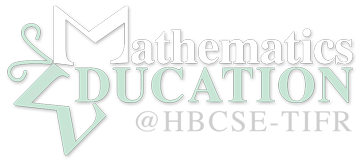Pentagrams and the Golden Ratio
Material Required: Thin strip of paper about 2 inches wide, plain paper and pen.
A pentagram is a regular pentagon with all possible lines joining corners drawn inside it, creating a star-like effect. The pentagram has such beautiful symmetry that it has been a powerful symbol in many cultures throughout history.
A pentagram is shown in the figure alongside. Ask students to try and answer the following questions by studying the figure.
- Consider ∆APR in the figure. Which other triangles is it similar to?
- How many triangles can you spot which are congruent to ∆APR
- Can you find all triangles congruent to those mentioned in item 1?
- Can you find the value of x? (Hint: use the similarity relation.) Express x both in the radical form and in the decimal form.
- Compute the value of 1/x and x2 . What do you notice? Can you arrive at this relation from the expression for x in the radical form?
- Write a few terms of the Fibonacci series. The series starts with 1. The second term of the series is also 1. To get subsequent terms we add the preceding two terms. The third term hence is 2 and the fourth term is 3. Now, assume that the ratio of successive terms in the series converges to a certain value as the number of terms become large. Can you find this ratio? Use the fact that each term is a sum of the preceding two terms.
It is not possible to construct the regular pentagon with ruler and compass. However there is a simple way in which a regular pentagon and hence the pentagram can be obtained. Take a 2 inch wide strip of paper which is about a foot long. Tie it into a simple knot taking care to see that the paper strip retains its full width inside the knot. Keeping it flat in this way and tying the knot carefully somewhat like a knot in a necktie, one obtains a pentagon. Draw all the diagonals of the pentagon. The resulting figure is a pentagram.
The golden ratio appears many times inside the pentagram. In the pentagram shown here, it is the ratio x : 1. x and 1 are the lengths of two unequal sides of the isosceles ∆PAR.
If you observe carefully, you will find that there are ten triangles in the pentagram which are the same size and shape as ∆PAR. ∆PGR is smaller, but it is similar to ∆PAR. There are five of these small triangles. Finally there is the big ∆PAN, which is also similar to ∆PAR. There are five of these big triangles.
In all these isosceles triangles the lengths of unequal sides bear the golden ratio. From this property the value of the golden ratio can be derived. An approximate value for the golden ratio is 1.618.
One of the peculiar properties of the golden ratio is that its reciprocal is equal to one minus golden ratio. Another peculiar property is that the square of the golden ratio is equal to one plus the golden ratio.
A golden rectangle is a rectangle which has its sides in the golden ratio. When three of these rectangles intersect each other at right angles and their mid-points coincide, you can join all the corners and get a regular Icosahedron. The ratio between two successive numbers in the Fibonacci series converges to the value of the golden ratio. The golden ratio has many connections with art, architecture, natural phenomena and regular decagons.

